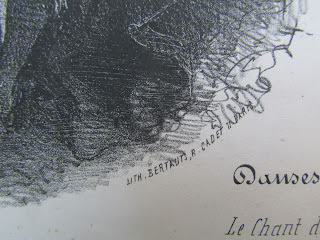Music Printing 3 - Lithography
With the invention of lithography, the printing of music was less costly, and therefore became more accessible to a wider public. This is where the Brocktorffs come in!
The inventor of lithography was the German playwright and actor ALOIS SENEFELDER (1771-1834). In the 1790s he was experimenting with methods of printing that were cheaper than the intaglio engraving available at the time. He came up with the idea of printing from polished stone - a process that by the early 19th century came to be known as 'lithography' (lithos - Greek for 'stone').
Fortunately, very early on, Senefelder was experimenting with using this stone printing process for the production of music. He went on to modify and create variations of his invention, improving the press over the following years. The process involved the use of polished stone, a greasy ink, nitric acid and gum arabic. The gum arabic encouraged the damp stone to reject greasy ink on the parts that were not to be printed. Music had to be written on stone in reverse in order to be printed and seen correctly. Other printing houses very soon took up this process and it spread widely. Artists also began to exploit the possibility of drawing artistically on title pages rather than using just lettering. The example below is a title page that was printed by lithography in Paris and published by 'C. Prilipp', who is actually the composer 'Camille Schubert'. He was instrument maker, publisher and composer.
Title page in black and white: Camille Schubert (1810-1889, Les Echos de l''Ame'. (ABC, AS Collection)
Lithographed music is always signed by the lithographer - 'LITH' and lithographer's name, and sometimes the address. This music reads LITH. BERTAUTS, R[ue] CADET 11, PARIS.
In the initial years, some publishers chose to print only the front artistic cover by lithography but went on printing the music by the older method of engraving that they knew best.
One of the earliest Maltese music lithographers deserves mention here. This was MAXIM GAUCI (1774-1854) who was born in Valletta, studied with Michele Busuttil, went to study in Rome, was working in Paris as a miniaturist in 1808, travelled to Egypt and the middle East, but settled in England in 1809, just when lithography was gaining ground. His lithography story unfolds entirely in England, away from Malta. He produced beautiful botanical works, portraits and a large number of the earliest lithographic music covers. Below is one of them, 'Buy a Broom', a song by (Sir) Henry Rowley Bishop (1787-1855) who was composer of music to the Theatre Royal, Drury Lane and also Pofessor of Harmony and Composition at the Royal Academy of Music. This title page says it is 'Drawn on Stone by M. Gauci' and dates to 1823-1833. The music inside is not printed in lithography but engraved.
'Buy a Broom' published in London. Printed by Goulding & D'Almaine, Drawn on stone by Maxim Gauci (ABC. P. Collection)
By 1829 lithography was being used in MALTA by artists such as Pietro Paolo Caruana, and very soon after by Michele Bellanti and the Schranz family. However, it was the BROCKTORFF family that started printing music lithographically by the 1830s ....and continued to do so throughout the 19th century.
Music Shops in Valletta In Malta, lithographically-printed music was sold in the shops of Valletta, alongside music printed by engraving. That printed by the method of lithography was cheaper to produce and was therefore usually sold at a more affordable price. A few hundred pieces could easily be printed from one stone. What's more, lithographically-printed music came to have attractively illustrated covers which were far more appealing. First they were in black and white, but by mid-century colour was added. Several other music covers can be viewed on the sheet music page of my Museum blog:
The Anna Borg Cardona Music Museum: Sheet Music Collection (abcmusicmuseum.blogspot.com)
'Espagna' by Emile Waldteufel (1837-1915) published in London by Enoch & Sons and sold at the S. FAVI Musical Establishment, 33 Strada Mezzodi, Valletta, 1880s (ABC,P.4)
 ,'Pas de Quatre' by Meyer Lutz, Ascherberg & Co, London c.1888 This was sold locally at the MUSIC DEPOT, 4D Strada Mezzodi (ABC, Y.G. 19). See The Anna Borg Cardona Music Museum: Pas de Quatre - Faust Up To Date (abcmusicmuseum.blogspot.com)
,'Pas de Quatre' by Meyer Lutz, Ascherberg & Co, London c.1888 This was sold locally at the MUSIC DEPOT, 4D Strada Mezzodi (ABC, Y.G. 19). See The Anna Borg Cardona Music Museum: Pas de Quatre - Faust Up To Date (abcmusicmuseum.blogspot.com)This is one of the pieces printed locally by the Brocktorff press in 1890. It is lithographically printed throughout, composed by Mro Luigi Vella, and dedicated to Dr Fortunato Mizzi at a time when there was an attempt at uniting the country by creating a National Day - the 8th of September.







